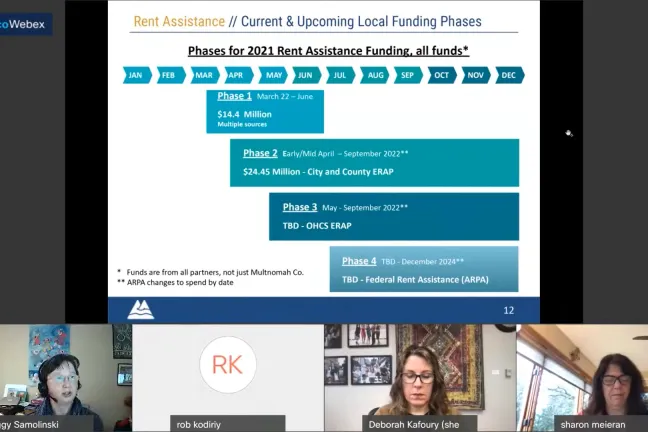The Board of County Commissioners approved an additional $14.4 million in emergency rent assistance Thursday, March 18, adding new funds to a massive, ongoing effort to protect renters impacted by the COVID-19 pandemic.
Since the outset of the pandemic, Multnomah County, the City of Portland, Home Forward, and a network of 43 community-based organizations have worked to get emergency assistance to renters across the County. Between March 2020 and January 2021, the coalition distributed almost $26 million in rent assistance to at least 16,000 residents in more than 5,800 households.
The $14.4 million consists of money passed to the State of Oregon, Multnomah County and the City of Portland through the federal government. The rent assistance is part of a broader strategy to protect renters, which includes a statewide eviction moratorium preventing people from being evicted due to nonpayment of rent until June 30, 2021.
“Even though there is a grace period there are many, many folks really struggling to pay their rent and we want people to stay stably housed to the greatest extent possible,” said Peggy Samolinski, who directs the
In order to distribute the funds, the County partners with a vast network of nonprofits and public programs. The programs are divided into four categories: long-established rent assistance partners; smaller, culturally specific community-based nonprofits; employment and skills training providers; and longstanding County programs. The 43 providers have deep relationships with the communities who need rent assistance the most.
Because the pandemic has disproportionately impacted Black, Indigenous and people of color, the County has centered those communities in its rent assistance program. Of those who have received these funds thus far, 84 percent identify as Black, Indigenous, or a person of color.
Based on the County’s data, certain zip codes are also more likely to be impacted by COVID-19, both economically and in terms of infection. More than 40 percent of rent assistance has gone to East County residents. Fifteen percent has gone to the Rockwood neighborhood in particular. “We really tried to focus on where the greatest need is,” said Commissioner Lori Stegmann, who represents East County on the Board.
A recent report from Portland State University found that 89,000 renters are behind on rent in the State. As of November, it’s believed that 27,000 renters in Multnomah County were not able to pay their rent in full. Based on the average household rent in the County, the estimated rent need is about $32 million a month.
“So serving 5,800 households is progress, and that’s about 20 percent of the need,” Samolinski said. “That’s pretty sobering for all of us as we think about how many renters are deeply impacted by this pandemic, and the limited resources we have.”
Beyond the constraints of serving people with limited resources, the massive undertaking also has presented administrative hurdles for the small nonprofits and agencies delivering the funds.
Samolinski said leaders are working to make it easier for communities to access funds through 211info. And behind the scenes, the County and Home Forward are going to take on additional work to make it easier for its partners to focus on delivering the rent assistance.
Looking forward, Commissioner Jessica Vega Pederson said the County must continue to prioritize households hardest hit by the pandemic. With limited resources, she said it’s important to use the available funds where they will have the greatest impact.
“Families with children should be one of the priority areas, especially as we’re moving out of this and children are returning to school,” Commissioner Vega Pederson said. “Providing them with stability is so important to the critical success of children, we know children who are experiencing houselessness have so many more additional challenges.”
More rent assistance is planned on top of the $14 million allocated Thursday. In April, the County and partners expect to distribute an additional $24.4 million from the Federal Emergency Rent Assistance Program allocated in December 2020. Even more funds will be available in May through state and new federal assistance programs, including the 2021 American Rescue Plan signed by President Joe Biden on March 11.
“Our systems were never designed to distribute direct assistance at this large of a scale,” Chair Deborah Kafoury said. “I know that we’re now well positioned for the additional dollars, and hopefully there will be more and more and more coming from us.”
Learn more about COVID-19 Eviction Moratorium Information

